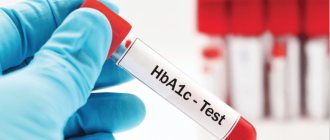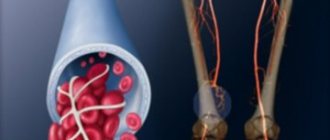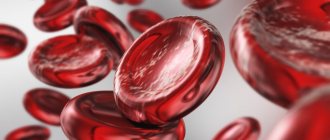Norm
The norm in this situation is considered to be 120-140 g/l. Numbers may vary, it all depends on the physical and mental state. A long decrease or increase in comparison with normal data indicates problems in the body.
In women, an increased rate is rarely observed. It is possible for hemoglobin to increase by 10-20 units; if the values are even higher, then you definitely need to go to the doctor and get tested. The reasons may be different: blood disease, congenital heart pathologies, oncology, cardiopulmonary pathology. This plasma substance is present in red blood cells, which are produced by the bone marrow. These scarlet bloody cells transport air to various organs. Therefore, with an increase in hemoglobin, there is probably an air deficiency in some area of the body. Because of it, the bone marrow forms a lot of red blood cells, and plasma coagulability increases.
| Floor | Age | Hemoglobin norm, g/l |
| Children | 0 – 14 days | 135-200 |
| Up to 1 month | 100-170 | |
| 1-2 months | 95-130 | |
| 2-4 months | 100-140 | |
| 4-6 months | 110-140 | |
| 6-9 months | 100-150 | |
| 9-12 months | 115-145 | |
| 1-5 years | 110-150 | |
| 5-10 years | 115-145 | |
| 10-12 years | 120-160 | |
| Man | 12-15 years | 120-160 |
| 15-18 years old | 120-170 | |
| 18-45 years old | 130-170 | |
| 45-60 years | 140-175 | |
| Over 60 years old | 120-175 | |
| Woman | 12-15 years | 110-150 |
| 15-18 years old | 120-155 | |
| 18-45 years old | 115-160 | |
| 45-60 years | 120-160 | |
| Over 60 years old | 110-170 |
Age norms of hemoglobin
Normal hemoglobin levels vary depending on the age and gender of the patient. For men, this figure is slightly lower than for women. They are characterized by the following norms.
| Age | Norm, g/l |
| 3 months | 114 |
| 6 months | 117 |
| 1 year | 116 |
| 3 years | 118 |
| Teens and mature men | 135-160 |
Since the functions of hemoglobin are to transport oxygen, its level is very important for the proper functioning of the body. For female patients, the table looks like this.
| Age | Norm, g/l |
| 3 months | 115 |
| 6 months | 119 |
| 1 year | 118 |
| 3 years | 120 |
| Teens and mature women | 120-140 |
If normal values increase by 10 or more units, it is necessary to prescribe therapeutic therapy and a diet that allows you to restore balance in the blood composition. Neglecting your own health can cause the development of many complications and pathologies that could have been avoided with timely diagnosis and treatment.
Causes of high hemoglobin
Increased level of hemoglobin in the blood in women, what is it? If this indicator changes, it means that there is a problem with a specific organ and system. Although sometimes high hemoglobin is the norm - for example, in people who live in the mountains or in elevated areas. The main reasons why high hemoglobin occurs in women are as follows:
- Hemoglobin often increases in those who smoke, as well as in those who have recently been in a fire. The fact is that hemoglobin easily transports air or carbon dioxide, replacing them with each other.
- A high level of water deficiency raises blood counts, resulting in an increase in the amount of circulating plasma.
- Congenital heart disease caused by high pressure in the pulmonary artery blood flow. In this situation, the skin color changes from infancy and has a blue tint. The child coughs frequently and has shortness of breath. Ultrasound of the heart allows you to determine an accurate diagnosis. Treatment of such pathologies with severe symptoms is only surgical.
- Pulmonary diseases.
- Excessive amounts of vitamins B6 and B12 in the human body.
- Cancerous neoplasms.
However, a high level of hemoglobin in the blood can not only indicate various diseases, but also signal that you lead a different lifestyle and live in an unfavorable place.
increased hemoglobin in women
Low hemoglobin symptoms
Hemoglobin levels can be easily measured using a laboratory blood test, which can be prescribed by the local physician observing the patient. If you suspect a decrease in hemoglobin, and there is no time to wait for an appointment at a city clinic, you can contact any private laboratory. Such institutions often offer discounts on comprehensive examinations. You can donate blood to such an institution any day. The laboratory will not require you to buy your own syringe and container.
Symptoms to suspect low hemoglobin levels:
- daily weakness that does not disappear even on rest days;
- pale skin;
- there is a decrease in memory;
- tremor of the limbs appeared;
- hair lost its shine and began to fall out;
- shortness of breath appeared;
- Heart rate increased even at rest.
At the first signs of a decrease in hemoglobin, you should consult a doctor or donate blood yourself to check the iron level in your blood. However, detecting a decrease in hemoglobin is not enough. It is important to determine the reason why the body lacks it.
Signs and consequences of increased hemoglobin
With a high level of hemoglobin in the blood, women may have no symptoms at all, but with a long and high value along with other diseases, the patient may have vague symptoms:
- constant fatigue
- desire to sleep,
- lethargy,
- loss of appetite,
- sleep problems,
- aches in joints and bones,
- high blood pressure,
- itching of the skin, particularly after showering and bathing,
- stomach ache,
- instant bruising and easy bruising.
All these symptoms disappear externally. But the most serious of them take place inside the body. There is an increase in the coagulability of the blood space, an increase in its concentration and a reduction in the speed of movement in the body. Because of this, the internal organs do not receive proper nutrition. If this condition is neglected, blood clots and plaques can form, which cause heart attacks and strokes.
Low hemoglobin - why it is dangerous
Hemoglobin is a complex chemical component of blood, which consists of protein and iron molecules. This constituent component is part of red blood cells and circulates through the bloodstream of the human body. The main task of hemoglobin is to transport oxygen molecules from the lungs to tissues, cells and internal organs.
With low hemoglobin, oxygen saturation of the body's cells decreases, which causes a decrease in immunity, a person loses vitality, organs do not receive proper nutrition, as a result of which their functionality is significantly reduced. Tissue cells suffer from oxygen depletion.
The most important complication of low hemoglobin is iron deficiency anemia. Its severe forms can cause loss of consciousness due to a high degree of brain hypoxia.
How to reduce hemoglobin in the blood?
If what causes hemoglobin to rise has nothing to do with serious illnesses, then you can influence it with a specific diet or medications. Among the pharmaceutical medications that can be easily purchased at the pharmacy, there are those that are aimed at thinning the blood: Trental, Cardiomagnyl, Curantil, Aspirin. Only a doctor should prescribe them! To reduce hemoglobin at home, you need to adjust your diet:
- Drink plenty of fluids per day. To do this you need to drink warm water. If you cannot do this, then saline drips are used.
- Reduce fats, sweets, eggs, as they increase cholesterol and so in a viscous environment.
- You should not take multivitamins or products that contain copper and iron.
- It is better to choose shrimp, fish, white meat, nuts, legumes, and vegetables.
- Also limit your intake of foods that increase hemoglobin. This is food enriched with protein and iron - red meat, red fruits and vegetables, offal, fish roe, butter, buckwheat, sweets.
Now you know why increased hemoglobin appears in a woman .
Is it dangerous to exceed the norm?
In some pathologies, the body begins to intensively produce hemoglobin. If the norm is significantly exceeded, the composition of the blood changes and the risk of blood clots increases. This is fraught with blockage of veins, impaired circulation in the extremities, and often causes cardiac ischemia or cerebral stroke. Possible reasons include:
- diabetes;
- pathologies of the thyroid gland;
- intestinal obstruction.
For women, a hemoglobin level above 150 g/l is considered dangerous. A disorder can be suspected by characteristic symptoms: high blood pressure, pale skin on the fingertips, frequent urination, joint pain.
Iron deficiency anemia during pregnancy
When carrying a child, a woman's body undergoes hormonal changes and the total blood volume increases. Doctors calculated what level of hemoglobin is considered critical for the expectant mother:
- mild anemia with a reading from 90 to 110 g/l;
- average at 80–90 g/l;
- heavy – below 80 g/l.
At risk are women with multiple pregnancies, patients with severe toxicosis or kidney disease. The interval between previous births and conception of less than 2 years increases the risk of anemia.
The main danger of critically low hemoglobin during pregnancy is disruption of embryo development. The child’s brain and nervous system experience oxygen starvation and lack of nutrients. There is a risk of congenital pathologies and anomalies, cerebral palsy. Therefore, gynecologists do not recommend refusing regular tests, offer vitamin complexes, and prohibit strict diets unless necessary.
Prevention of anemia
It is necessary to monitor hemoglobin levels constantly and at any age. The well-being and performance of a person depend on the value of the indicator, so the danger of pathology should not be underestimated. To avoid anemia, it is important to remember the rules of prevention:
- proper and balanced nutrition;
- reducing portions of coffee and alcohol;
- physical activity;
- compliance with the drinking regime.
To fully absorb iron from food, it is necessary to consume meat products at the same time as greens and vegetables. A large amount of the beneficial element is found in liver, pork and mushrooms, legumes, oatmeal and corn grits, and offal. Instead of sweets, it is better to lean on dried fruits and cashew nuts, hazelnuts, and fresh blueberries. Folic acid and B vitamins strengthen the binding in the molecule and stimulate the production of hemoglobin.
During pregnancy, diet or toxicosis, it is necessary to take complex vitamins. They should be selected by a specialist based on tests and after examining the patient. Doctors do not recommend raising hemoglobin with drugs containing high iron content without medical indications. With proper nutrition, the indicator increases in 20–25 days to normal levels.
Important! To prevent anemia, nutrition should be varied at all times. For example, during fasting or a vegetarian diet, meat is replaced with dried mushrooms and legumes, desserts are prepared from honey with nuts, and beet salads.
A critical hemoglobin level often develops gradually and without significant symptoms. In this case, irreversible disturbances in the functioning of organs and systems occur, which have to be treated in a hospital for a long time. Therefore, it is necessary to promptly identify and eliminate the cause, and not neglect preventive measures and doctor’s recommendations.
What level is considered lethal?
Experts believe that the lethal level of hemoglobin for an adult is below 70 g/l. In fact, the patient dies not from a lack of protein, but from the development of complications due to oxygen starvation:
- metabolic disease;
- drop in immune defense;
- exacerbation of chronic diseases of the kidneys, liver, intestinal tract;
- severe arrhythmia or tachycardia.
With acute and massive blood loss and a drop in hemoglobin below 38 g/l, the patient dies from cerebral hypoxia. But with a slow decrease in iron-containing protein, symptoms appear gradually, the body adapts to the changes. Therefore, in medical practice there are many cases where a person with anemia at a level of 40–50 g/l works productively and leads a relatively active lifestyle. This is due to the individual characteristics of the patient’s cardiovascular and nervous system, his age and health.











